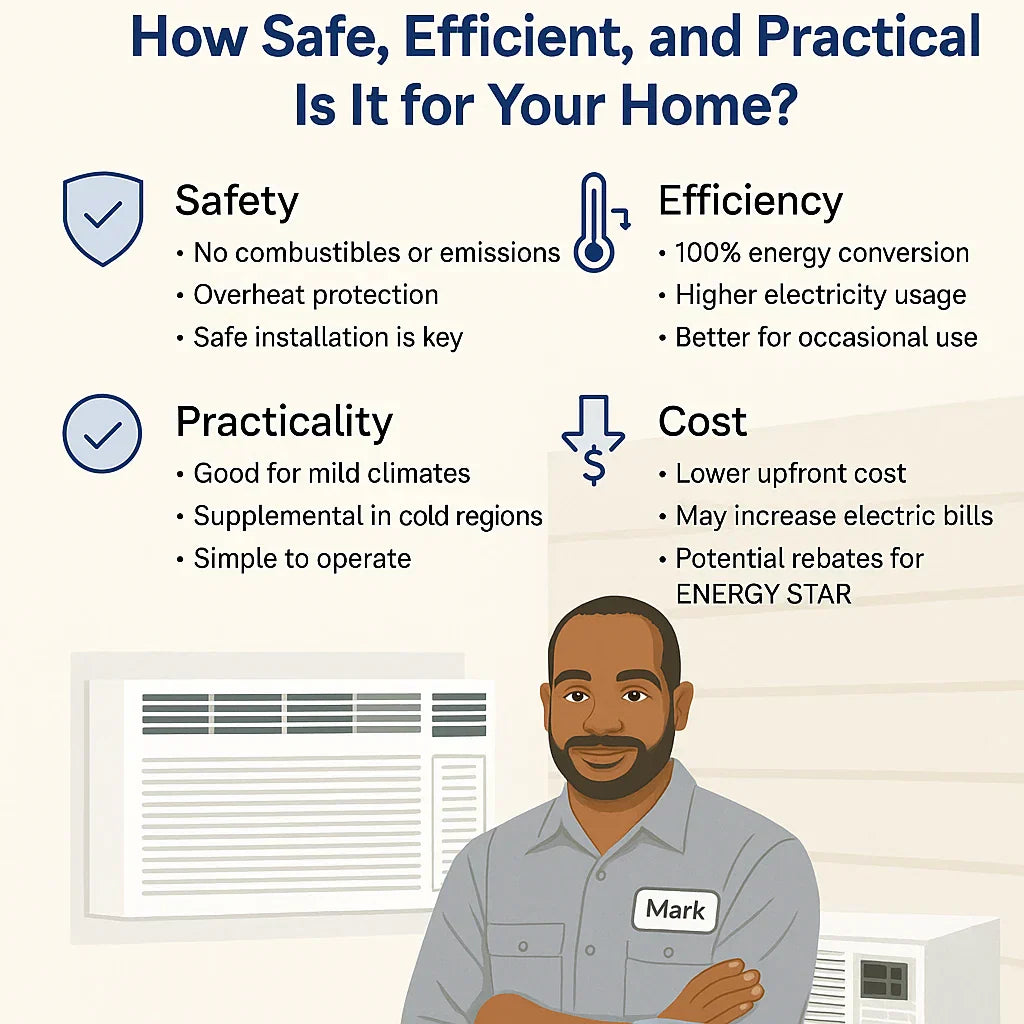If you’re considering a through-the-wall air conditioner with built-in electric heat—like the GE AJEQ12DWJ 12,000 BTU unit—you’re likely asking: Is electric heating safe? Is it efficient? And will it really keep my room warm in the winter?
For homeowners like Mark, who value reliability and simplicity over high-tech systems, electric resistance heat built into a wall unit can be a practical, low-maintenance solution. But it also has its limits.
This guide dives into how electric heating works in wall units, the safety features involved, its real-world efficiency, and whether it’s the right fit for your climate and budget.
⚙️ How Electric Heat Works in Wall Units
Electric wall units like the GE AJEQ12DWJ use resistance heating elements, similar to a toaster or space heater. Electricity passes through metal coils, generating heat that’s blown into the room by a fan.
Unlike a heat pump, which transfers existing heat, resistance heaters create heat from scratch, making them:
-
Fast to warm up
-
Simple to maintain
-
Less efficient over time
📌 The AJEQ12DWJ provides 11,000 BTUs of electric heat, suitable for spaces up to ~450–550 sq. ft.
🔒 Is Electric Heat Safe in Wall Units?
✅ Built-in Safety Features
Wall units with electric heat include several safeguards:
-
Thermal overload protection: Shuts off the unit if internal temperatures exceed safe limits.
-
Tip-over and tilt sensors (for portable versions): Not needed in wall units but used in similar technologies.
-
Temperature-limiting thermostats: Prevent overheating.
-
Metal housing and insulation: Reduce fire risks.
⚠️ Homeowner Safety Best Practices
-
Never block the airflow or cover the unit
-
Avoid using extension cords (always plug directly into a 208/230V receptacle)
-
Inspect the power cord annually
-
Keep combustibles at least 3 feet away
🔗 Consumer Product Safety Commission – Home Heating Safety Tips
💡 Is Electric Heating Efficient?
Electric resistance heating is 100% efficient at the point of use, but that doesn’t mean it’s cost-effective.
Comparison of Heating Technologies:
| Type | Efficiency | Energy Cost | Best Use |
|---|---|---|---|
| Electric Resistance (GE AJEQ12DWJ) | 100% | High | Small rooms, mild climates |
| Heat Pump | 250–300% | Low | Year-round primary heat |
| Natural Gas Furnace | 85–98% | Medium | Whole-home systems |
In mild climates or as a supplemental heater, wall-unit electric heat is practical. In colder zones (below 25°F), it becomes costly to run full time.
🔗 Energy.gov – Electric Resistance Heating Overview
🌎 Environmental Impact
Electric resistance heat:
-
Produces no on-site emissions
-
Can be powered by renewable energy (if your electricity source is green)
-
Still generates high grid demand compared to heat pumps
For eco-conscious homeowners, using electric heat only during peak demand (cold snaps, shoulder seasons) is better than running it all winter long.
🧑🔧 When Is Electric Heating in Wall Units Practical?
✅ Ideal Scenarios:
-
Supplemental heat in a basement, sunroom, or garage
-
Apartments or rentals without central heat
-
Warmer states (e.g., FL, TX, CA) where heating is occasional
-
Vacation homes or zones with individual climate needs
❌ Not Ideal For:
-
Whole-home heating in cold states (e.g., MN, NY, ME)
-
Homes with high winter energy costs
-
Energy efficiency rebate programs (electric resistance heat usually does not qualify)
🔗 IRS Energy Efficiency Tax Credit Info
🧠 Pros & Cons of Electric Wall Heat
✅ Pros:
-
Simple, low-maintenance
-
No combustion or gas lines
-
Heats quickly
-
Fits compactly into single rooms
❌ Cons:
-
Expensive to operate continuously
-
Not rebate-eligible under most programs
-
Less effective in below-freezing conditions
Mark’s Take:
"For my guest room and the den, it’s perfect. I just flip on the heat in the morning when I need it—it warms up fast and I don’t have to mess with ductwork or schedules. But I wouldn’t heat the whole house with it."
🧰 Maintenance & Safe Operation Tips
-
Clean the filter monthly
-
Vacuum the coil and fan before winter
-
Test the thermostat and safety shutoff in fall
-
Inspect electrical cord and plug annually
-
Don’t use with a power strip or surge protector
🔗 Verified External Resources
🏁 Final Thoughts
Electric heating in through-the-wall AC units is safe, reliable, and convenient—especially in small spaces or warmer regions. For occasional use, it delivers quick warmth without the need for ducts or gas. But for whole-home or primary heating in colder climates, it’s better as a supplement rather than a solution.
If you’re considering the GE AJEQ12DWJ or a similar model, check your climate zone, electric rates, and usage pattern to decide if resistance heat is the right fit for you.
In the next topic we will know more about: Noise Matters: How Quiet Is the GE AJEQ12DWJ Compared to Other Wall Units?







